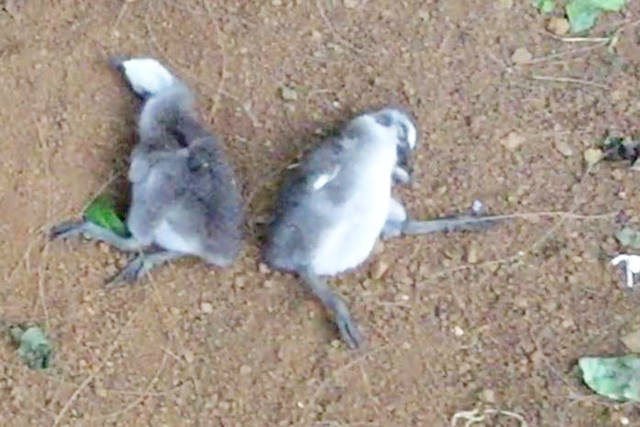PRINCEVILLE — The government shutdown is slowing the investigation into the deaths of two nene chicks in Princeville, as necropsy on the animals is the U.S. Geological Survey’s responsibility.
The USGS is one of several agencies impacted by the shutdown, with only staff that’s necessary for the protection of life and property allowed to work until the government reopens.
But a spokesman from the state’s Department of Land and Natural Resources said they’re following up on the discovery, which was reported Thursday by Princeville resident Terry Chao.
Chao routinely walks a trail by the Westin Princeville Ocean Resort Villas, and checks on a family of nene that is usually in the area, off of Wyllie Road. She ran across the dead birds Wednesday afternoon, in a grassy area close to the Westin.
“First of all, I wondered why they died,” Chao said. “They died at the same time, right next to each other.”
Chao wonders if dogs or poison had anything to do with the deaths, because she routinely sees loose dogs running the trail, and says people use poisoned food to rid the area of chickens and roosters.
“I’ve found so many roosters and chickens that die from loose dogs with no leash, and I don’t find any marks on them. They hold it just like a toy, but (if you investigate), you’ll see internal bleeding,” Chao said.
She continued: “It’s hard to believe that people would put poison out there, but I know people do. One time six roosters died, all in two days. That’s on the borderline of the trail and the area” where she found the nene.
Efforts to increase the population of the endemic nene, or Hawaiian goose, have been ongoing since they were first listed as endangered in 1967. In 1960, there were only 30 birds left. Today, there are more than 2,800 nene, with a large percentage of that population on Kauai.
The numbers increased so much, in fact, that problems like vehicle strikes are on the rise, too.
At the beginning of 2017, DLNR launched a public education campaign and conversations with the state Department of Transportation to try to limit the number of nene and vehicle collisions along Kuhio Highway in Hanalei and in Kekaha, where birds frequently cross roadways.
According to DLNR, the greatest number of nene deaths occur around the Hanalei Bridge and on Kilauea Road near the Kilauea Point National Wildlife Refuge between December and April — peak breeding and molting season.
But Chao said it’s apparent that these two most recent nene gosling deaths didn’t involve a vehicle — they weren’t near the roadway, and they were discovered by some bushes between the trail and the Westin’s grassy picnic area.
“I’ve been thinking about all the possibilities. I don’t think it was sickness. They don’t die right next to each other if it’s sickness,” she said. “I recommend the wildlife (officials) put signs that protect the nene from the dogs, and they should advise the hotel to tell visitors that this is a protected bird since they have people coming from all over the world.”
•••
Jessica Else, environment reporter, can be reached at 245-0452 or jelse@thegardenisland.com.



Cats?
From the Kauai Humane Society website regarding Leash Law:
“Enforcement of these laws depend on the jurisdiction – State DOFAW/DLNR enforce State properties, County park rangers enforce County parks along with Kauai Police Department and we, the Kauai Humane Society enforce everywhere else like in our neighborhoods etc. along with KPD. State law violations like a loose dog not under leash control by it’s owner on State land or beach are subject to high fines as well as County park violations where all animals are prohibited (up to $500 I believe). Dogs loose in neigbhorhoods are subject to violations of Chapter 22 which requires appearance in court and minimum fines of $50 up to maximum fines of $250.”
another dead nene tonight and NO ONE is removing this bird. what is going on at this resort???